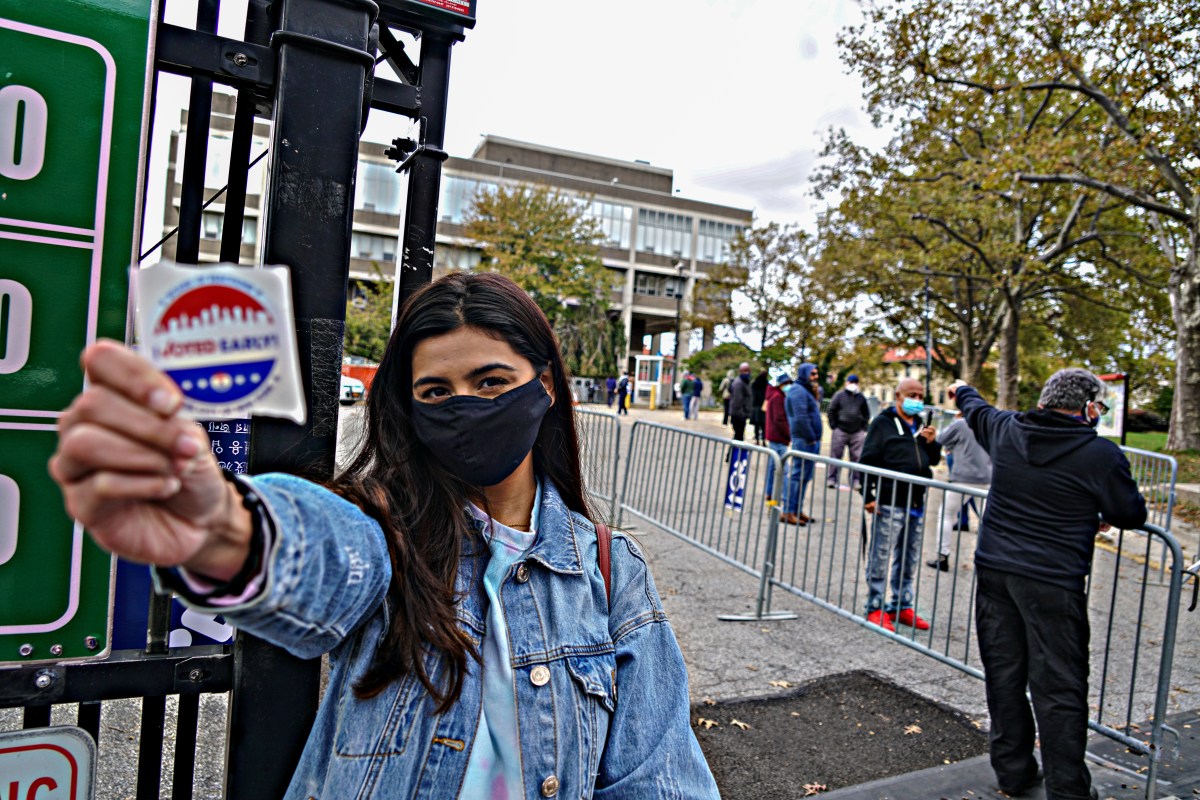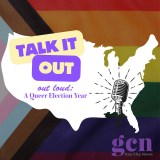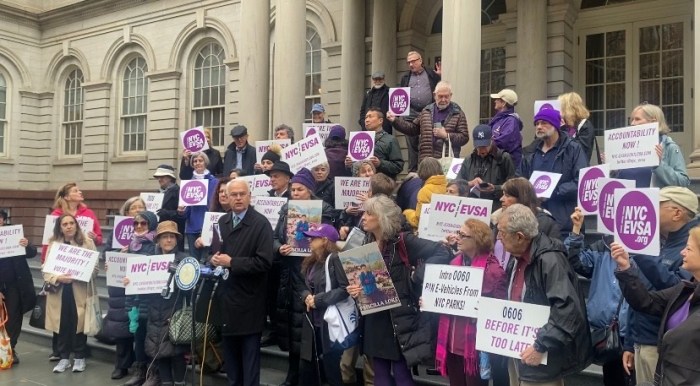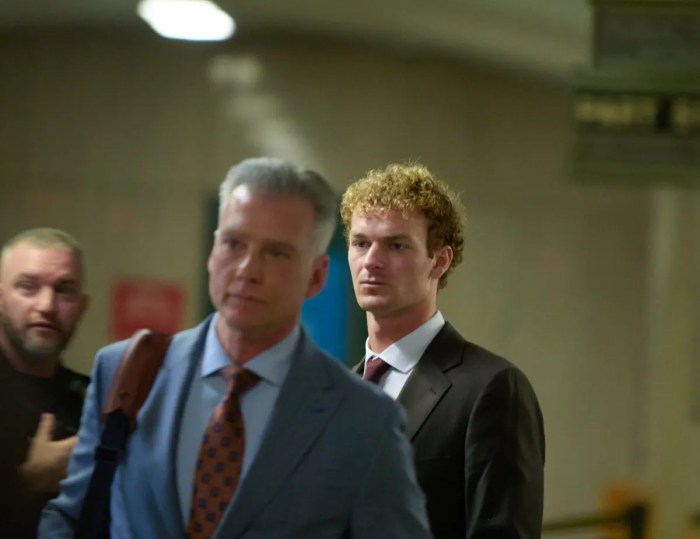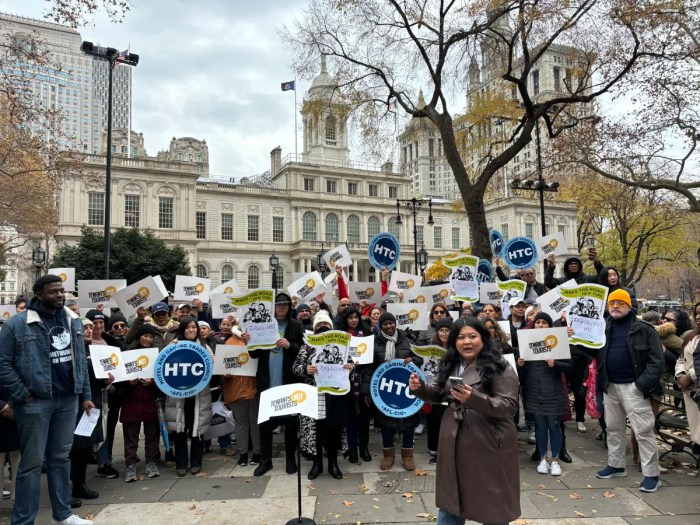Queens residents in City Council District 24 will make history as they will be the first voters ever to use the new ranked-choice voting (RCV) system in the city’s first special election this year on Feb. 2.
To educate voters about RCV and their voting rights, Queens College on Jan. 14 hosted a community and ethnic roundtable discussion on RCV.
Queens College President Frank Wu was joined by J. Phillip Thompson, deputy mayor of Strategic Policy Initiatives; James Vacca, distinguished lecturer of Urban Studies at Queens College; Laura Wood, senior adviser and general counsel of Democracy NYC; and Dr. Sarah Sayeed, chair and executive director of NYC Civic Engagement Commission.
The college, located at 65-30 Kissena Blvd. in Flushing, will serve once again as a polling site, so people could exercise their rights and fulfill their responsibilities, according to Wu.
“It’s important that everyone in the community is fully informed and understands how ranked-choice voting works, especially in light of the imminent municipal elections, we all need to encourage voter awareness and voter participation,” Wu said. “Now, more than ever, we’re hosting this function because it’s the mission of Queens College to prepare students to become leading citizens of an increasingly global society.”
Early voting for the Council District 24 special election begins on Jan. 23. Voters are encouraged to complete their mail-in ballot request online by Jan. 26 and check “temporary illness” on the application. All mail-in ballots must be signed, completed and postmarked by Election Day, Feb. 2, or dropped off at a polling site during voting hours or an NYC Board of Elections office.
There are eight candidates running to represent Council District 24, which includes the neighborhoods of Kew Gardens Hill, Pomonok, Electchester, Fresh Meadows, Hillcrest, Jamaica Estates, Briarwood, Parkway Village, Jamaica Hills and Jamaica.
The candidates are Michael Brown, James Gennaro, Neeta Jain, Moumita Ahmed, Deepti Sharma, Soma Syed, Dilip Nauth and Mujib Rahman.
See our Voters Guide for the District 24 special election here.
With RCV, voters will have the option to rank five candidates from the group of eight candidates. While RCV is the new current system of choice, many voters, particularly those in immigrant communities, may not understand how to vote for their candidate of choice in the upcoming special election.
So, what is ranked-choice voting, and how does it work?
In November 2019, New York City voters approved a measure to enact RCV for local primary and special elections beginning in 2021. This made NYC the most populous jurisdiction in the U.S. to employ the RCV voting election method.
RCV is an electoral system in which voters can rank up to five candidates — first, second, third, fourth and fifth — by preference on their ballot.
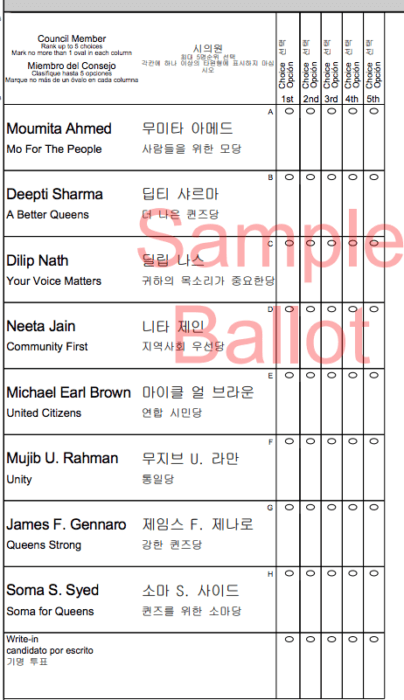
For example, if you like Candidate A the best, but you also like Candidate B and to a lesser extent Candidate C, you can rank Candidate A as your first choice, Candidate B as your second and Candidate C as your third. You don’t have to rank all five; you can choose just one candidate.
But the option is there for voters to voice their support for multiple candidates. For the voter, all they have to think about when going to the ballot box is which candidates to choose and how to rank them.
If a candidate wins a majority of first-preference votes, he or she is declared the winner. If no candidate wins a majority of first-preference votes, the candidate with the fewest first-preference votes is eliminated.
First-preference votes cast for the failed candidate are eliminated, lifting the second-preference choices indicated on those ballots. A new tally is conducted to determine whether any candidate has won a majority of the adjusted votes. The process is repeated until a candidate wins an outright majority.
One thing that voters cannot do is vote for two candidates for their first preference; doing so would invalidate the ballot. Also, since absentee ballots will need to be counted, the winner might not be announced on election night.
“Even if your first choice doesn’t win, one of your other choices might win,” Thompson said.
According to Thompson, RCV improves voters’ chances of having their voices heard on policy issues they care about. It also means that candidates’ cycles will focus more on the issues and less on specific candidates, which is good for all voters, particularly in citywide or countywide elections.
Primary elections that will have RCV include mayor, public advocate, comptroller, borough president and City Council. Primary elections that will not have RCV include the president, governor, Congress, state Legislature and district attorney.
However, for the general election in November, voters will only vote for one candidate, as they’ve done in the past.
Questions have been raised about why the city is moving toward RCV and one of the facts is that the new system will eliminate runoff elections for mayor, city comptroller or public advocate, where there has been low voter turnout in the past.
“Unlike the old system where candidates could win with just a small plurality of votes in some cases with RCV, candidates must have an outright majority to win,” Wood said. “One of the hopes I think of supporters of ranked-choice voting is that it will help ensure that candidates put together a broader coalition of voters, because again, candidates will need voters beyond the first choice in order to put that coalition together to win.”
Voter outreach
When asked about Council District 24, which is home to a population of Bangladeshi residents who may not understand RCV and how to fill out their ballot, the panelists said they’re developing resources and identifying the needs of the communities by crafting materials and messaging that will be useful.
For example, Democracy NYC and the NYC Civic Engagement Commission are conducting outreach training workshops and are hoping to establish more dates in the future, according to Wood.
Additionally, Democracy NYC is doing a lot of direct voter outreach, primarily through phone banks to educate voters, and creating social media tool kits, among other resources from organizations.
Together, the agencies are working to equip limited English proficiency voters with knowledge about their rights and the voting process through a public service announcement (PSA) video published on YouTube, along with translations and 11 languages including Arabic, Bengali, Chinese, French, Haitian, Creole, Korean, Polish, Russian and Italian.
“Queens as we know is, is the most diverse county in the country and in a city where there are over 200 languages spoken it’s essential that we work with community and ethnic media local community-based organization civic institutions and all of our neighbors to help spread the vote about ranked-choice voting and voting rights,” Sayeed said.
The Board of Elections and Campaign Finance Board are sending out mailers to every registered voter in Council District 24 with information about the election and RCV.
It’s noted that all New Yorkers have the right to bring a friend, family member or poll worker, but not an employer or union rep to serve as their interpreter at the voting booth.
Democracy NYC and the NYC Civic Engagement Commission will be working with community boards to provide training on RCV in partnership with the Queens borough president’s office and the Campaign Finance Board.
The panelists are encouraging civic actors, community-based organizations and schools to step up and raise awareness about voter outreach, voting rights and RCV.
“We’re mounting a campaign from the city side but one of the things we’re trying to do is encourage people to do the same and to work with us, so that all voters really understand this change, and how to make use of it,” Thompson said.
For information about ranked-choice voting, and to see who is running and learn how and where to cast your ballot, visit voting.nyc. For more information on your voting rights, go to The New York City Civic Engagement’s election information site at nyc.gov/wearevoters.

